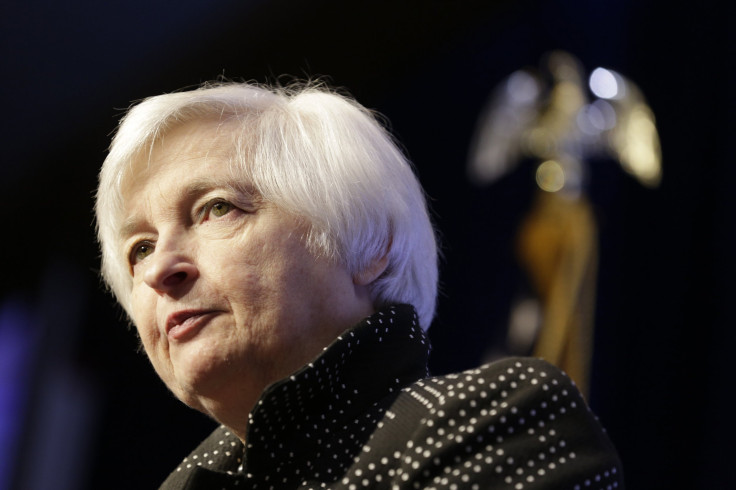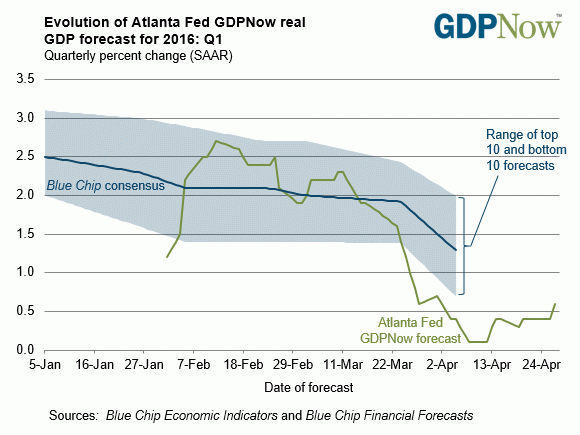US Federal Reserve, Holding Interest Rates Steady, Shows Less Trepidation Over Global Economic Risks

After a two-day meeting, the Federal Reserve on Wednesday released its latest policy update, keeping benchmark interest rates on hold and nodding — if weakly — toward a potential June interest rate hike.
Traders and economists routinely probe the Fed’s regular monetary updates for insights into how America’s top economic policymakers view the current state of the U.S. economy. Subtle changes in the text from month to month can indicate notable shifts in the central bankers' outlook.
Here are three key takeaways from Wednesday’s monetary policy statement.
1. Is a June hike in the cards? Analysts had expected the Fed to nod toward a possible interest rate hike in its next meeting in June. Wednesday's statement provided a less gloomy outlook on the state of global economic conditions, indicating a greater openness to raising interest rates in June.
Notably, the Fed saw fit to strike worrisome language from the previous statement noting the “risks” posed by “global economic and financial developments.” The removal of the language is a sign the Fed's biggest worries have abated in recent months.
Still, Fed Chair Janet Yellen and her colleagues abstained from explicitly signaling a June rate hike is coming.
After the October 2015 meeting — the last before the Fed’s decision to raise interest rates for the first time since 2006 — policymakers included a line mentioning “whether it will be appropriate to raise the target range at its next meeting.” That language did not return in Wednesday’s statement, casting some doubt on a June hike.
Prior to the release, markets priced in a mere 21 percent chance that the Fed would hike in June, according to data from the CME Group. Those odds rose slightly, to 23 percent, in the half hour after the statement was publicized.
In March, Fed officials predicted two rate hikes this year, down from four last December. The Fed's benchmark interest rate currently hovers between 0.25 percent and 0.5 percent.
2. ‘Balance of risks’ is still absent. Another piece of language watched closely by investors also failed to appear in Wednesday's statement. The Fed saw fit to leave out any evaluation of the “balance of risks” faced by the economy. Analysts at Goldman Sachs wrote last week in a report that the reinsertion of the balance-of-risks clause would signal a greater willingness on the part of Fed officials to raise rates in June, or at least to keep the option open.
In previous statements, the phrase has served as a barometer of policymakers’ general assessment of the challenges and opportunities facing the economy. But the language disappeared in January and March as Fed officials dissented over the scale and ultimate impact of market swings in the first quarter.
According to minutes from the Fed's March meeting, “many participants expressed a view that the global economic and financial situation still posed appreciable downside risks to the domestic economic outlook.”
Earlier this year the Fed’s relatively rosy economic projections from 2015 were blown off course by headwinds from abroad, including stumbles in China’s economy and the dual impacts of the rising U.S. dollar and falling oil prices.

These stresses have since subsided, but there’s still reason for concern. Leading economic data — from home sales to consumer spending — have come up softer than expected. Projections of economic growth for the first three months of 2016 have sunk from above 2 percent to below 1 percent, clouding policymakers’ crystal ball.
After noting moderate economic expansion in March, the Fed on Wednesday warned: “Economic activity appears to have slowed.”
3. Transitory language. In March's Federal Open Markets Committee statement, Fed officials warned over the “transitory” effects of unfavorable exchange rates and sinking energy prices keeping inflation down. That language remained nearly identical in Wednesday's release.
“Inflation is expected to remain low in the near term, in part because of earlier declines in energy prices, but to rise to 2 percent over the medium term as the transitory effects of declines in energy and import prices dissipate,” the statement read.
Policymakers will be watching coming economic reports carefully to get a firmer grasp on how the data are shaping up for a rate hike in June, which would serve to pump the brakes on growth and inflation. Fed officials want to be sure the economy has sufficient momentum before doing so.
Employment gains have remained strong in recent months, with employers adding an average 209,000 jobs a month since January. Overall labor force participation rates have shown a durable upswing, suggesting that the remaining pockets of slack in the economy, long a concern for Yellen, are shrinking.
On the flip side, however, inflation has held below the Fed’s 2 percent objective for more than three years. Recently, the Fed’s core inflation measure, which excludes food and energy prices, has edged up to 1.7 percent, aided in part by the falling dollar.
But Fed officials have warned the gains may be transitory, and will be on the lookout for a more sustained rise in prices before determining the economy is hot enough to weather the chill of higher interest rates.
On Thursday morning, the Commerce Department releases its report on first-quarter GDP growth, which is expected to show U.S. economic growth rising at a 0.7 percent annual rate in the first three months of the year after a rising at a 1.4 percent rate in the fourth quarter of 2015.
© Copyright IBTimes 2025. All rights reserved.






















